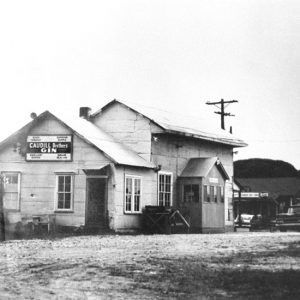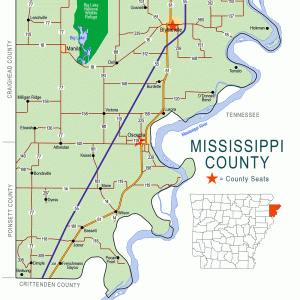calsfoundation@cals.org
Milligan Ridge (Mississippi County)
Milligan Ridge is a small farming community located along State Highway 158 in the western portion of Mississippi County. It is a part of what is known as “Buffalo Island.” Big Lake and Little River separate the island from the remainder of Mississippi County on the east. The area has the distinction of being one of the last in the state to be claimed for farming from the swampy land around the Mississippi River.
A few people inhabited the mosquito-infested swamplands as late as the 1890s. They came to the area to trap, hunt, and fish, or to hide from the law. For example, Lucilius Steven Milligan and his sons, James Riley and Jacob Minton Milligan, were running from the law in Union County, Illinois. They had been accused of stealing horses, and the remote, swampy terrain was a perfect hiding place. Eventually, the elder Milligan acted as a hunting guide for sportsmen, usually from out of state, leading them into the dense woods to kill or trap the readily available wildlife. Although the area was unfit for farming, he homesteaded 160 acres in 1896. He built a cabin on the five-acre ridge that remained dry during the spring floods and raised hogs to sell in nearby towns; after five years, he received a patent on his land from the U.S. government. His homestead became known as Milligan Ridge.
In 1905, several men, including local timber mogul Robert E. Lee Wilson, acknowledged the enormous potential of Mississippi County for farming even though only five percent of the county was in cultivation. Drainage districts were formed to reclaim the swamplands, and Chicago Mill and Lumber Company cleared the cypress and hardwood from the dense forests. Its land-clearing efforts, combined with a successful program of flood control and drainage, using ditches and levees, provided thousands of acres of potential farmland.
Just prior to World War II, homesteaders and sharecroppers moved into the area, and Milligan Ridge’s population reached an all-time high; in 1940, the Little River township boasted 415 pupils in its school district. The pioneers built homes, schools, churches, and businesses on the land.
However, mechanization dramatically changed farming and the area’s demographics in the late 1950s and early 1960s. The typical forty-acre farm of the 1930s evolved into an average 1,725-acre farm. Labor-intensive farming techniques and mules were replaced by a variety of machines. Businesses and churches closed as people moved away to find factory jobs. By 1962, the school consolidated with nearby Manila’s school. In 2001, the only remaining store and the cotton gin ceased operations, leaving the Baptist church as the only entity left in the community. Milligan Ridge, like many small Arkansas farming communities, could not compete with the forces of change.
For additional information:
Harrison, Robert W. “Clearing Land in the Mississippi Alluvial Valley.” Arkansas Historical Quarterly 13 (Winter 1954): 352–371.
Jackson, Donna. “Milligan Ridge: The Development and Decline of a Farming Community, 1920–1962.” MA thesis, Arkansas State University, 1994.
Simonson, S. E. “Origin of Drainage Projects in Mississippi County.” Arkansas Historical Quarterly 5(Autumn 1946): 263–273.
Donna Brewer Jackson
Manila, Arkansas
 Milligan Ridge Gin
Milligan Ridge Gin  Mississippi County Map
Mississippi County Map 



Comments
No comments on this entry yet.